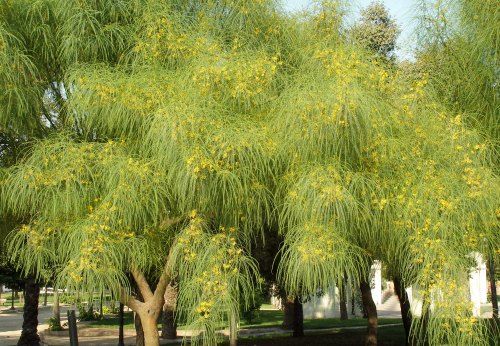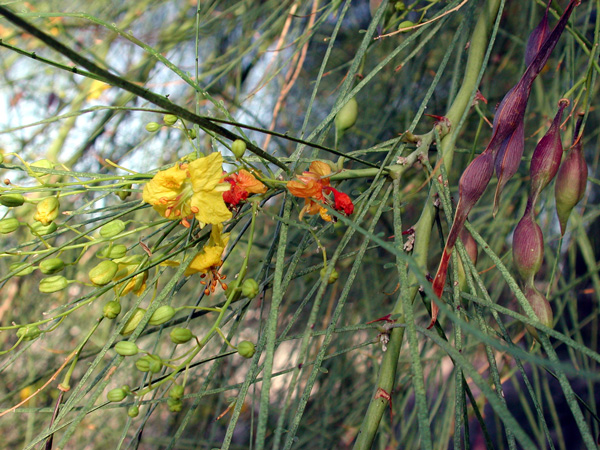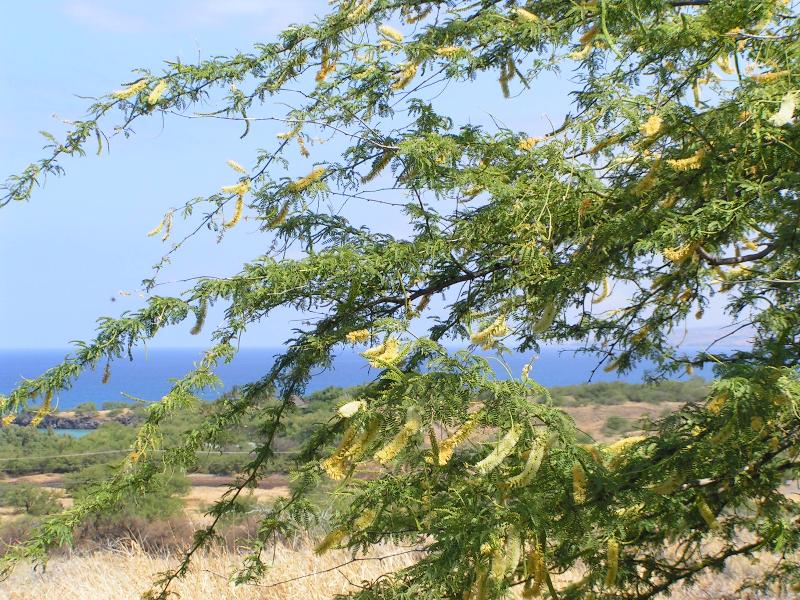Jerusalem Thorn
Jerusalem Thorn (Parkinsonia aculeata)

Hawai‘i-Pacific Weed Risk Assessment Score: 20, High Risk.
Regulatory Status: None.
Prevention and Control Category: BIISC EDRR Species
Description
Jerusalem thorn is a shrubby thorny tree that grows to 9-30′ tall. It has smooth green bark
and thorns along its branches. Feathery leaves are formed by long flat ribbon-like stems measuring 10-16″ in
length with 22-30 pairs of small leaflets. Jerusalem thorn has small (1″) yellow flowers with orange spots that hang in groups. This plant has green seed pods with brown or purple spots  that range from 2-8″ long.
that range from 2-8″ long.
Impacts
Jerusalem thorn has been planted throughout the world as an ornamental and has since escaped from cultivation. Its distinctly shaped leaves, yellow flowers, weeping-like habit, drought tolerance, and ability to grow in a variety of soils makes it an appealing ornamental. In Australia, Jerusalem thorn can form dense, thorny, impenetrable thickets along watercourses and drainages.
Distribution
The full extent of Jerusalem thorn’s native range is uncertain. However, it is widely cultivated around the world and is known to have spread from initial plantings in California, Arizona, Florida, the main Hawaiian Islands, the West Indies, Australia, and Micronesia. Jerusalem thorn seeds are dispersed via waterways and during flood conditions. It is also dispersed by animals that eat its seeds and humans who spread the plant long distances in landscaping.
What you can do
If you see this species call your local ISC and/or visit www.reportapest.org.
Look-alike Species

Image Credit: archive.constantcontact.com
Kiawe (Prosopis pallida): Kiawe is the common thorny mesquite found primarily in dry and coastal areas. It grows
up to 40′ tall, has 1″ thorns, yellow catkin (caterpillar-like) type flowers, and yellow seed pods. Jerusalem thorn can be differentiated by its long flat ribbon-like stems and yellow flowers. THIS PLANT IS ALSO INVASIVE.
For additional information, visit:
-
The Hawai‘i Invasive Species Council, https://hisc.hawaii.gov
-
Parkinsonia aculeata on Maui. Starr et al. 2003. https://www.hear.org/starr/hiplants/reports/pdf/parkinsonia_aculeata.pdf
-
Konaside NPS Invasive Species field guide: https://science.nature.nps.gov/im/units/pacn/assets/docs/Invasive_Species_Cards_and_Calendars_PBIN/NPS_CARDS_KONA_12112012_final.pdf